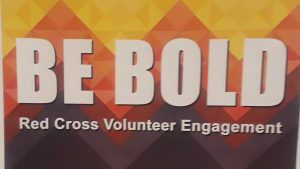by Beth Steinhorn, President, VQ Volunteer Strategies
This morning, after nine months of research, design, and preparation, I excitedly sat in the launch of a three-day training for engagement specialists of the American Red Cross – all designed around the theme of “Be Bold.” While we had been enthusiastically integrating the concept into training design over recent months, I was still taken aback as I watched this theme of “Be Bold” transform from a jazzy, bright graphic into an anthem for all engagement professionals, not just the 250 Red Crossers in the room today.
 What does boldness have to do with volunteer engagement? Perhaps you would envision the occasional need to boldly face a volunteer who is resistant to change, or you might consider the boldness required of asking for a raise. While those scenarios certainly require assertiveness, that isn’t what I am talking about.
What does boldness have to do with volunteer engagement? Perhaps you would envision the occasional need to boldly face a volunteer who is resistant to change, or you might consider the boldness required of asking for a raise. While those scenarios certainly require assertiveness, that isn’t what I am talking about.
Boldness is about embracing your role as a leader of engagement rather than just as a manager of volunteers. Boldness is about being a leader who inspires the organization to embrace engagement as a strategy, not just as a program. Boldness means establishing a vision, making the case for that vision, aligning others with it, and equipping others for success in engaging volunteers.
Boldness involves courage, confidence, clarity, bravery, and assertiveness. Boldness – like courage – does not require being fearless. Rather, being courageous and bold is the ability to move forward despite fears. Popular culture has us believe that courage is reserved for firefighters running into burning buildings to save someone, but, in reality, leading an organization to optimize engagement is a bold and courageous move as well. The first step to moving forward despite fears is becoming aware of the fears that hold us back, and then equipping ourselves to move forward despite those fears.
Here are the fears we commonly hear about and observe as we work in the field.
- Fear of change: Challenging the status quo can feel risky, especially since it might mean shifting from the comfortable position of doing things “the way they’ve always been done.” So, it’s vitally important to be able to make the case for why change will benefit the organization and your colleagues – what they have to gain from change, and what they have to lose by not changing.
- Fear of challenging others: Encouraging others to engage volunteers may require them to face their fears and they may not be ready to do so. Training and support are vital to allaying fears and equipping them for success.
- Fear of risk: Risk and experimentation means opening oneself up to failure. Yet, failures aren’t failures if we learn from them. By piloting change incrementally, an organization can embrace a learning mindset.
- Fear of uncertainty: Change inevitably involves uncertainty which can be unsettling to say the least. Yet, by reiterating the long-term benefits, involving colleagues in the process, and communicating often to keep people informed, you can help other face the uncertainty and ease their discomfort.
- Fear of being vulnerable: Many people are uncomfortable asking for or accepting help. Yet, to quote another client of ours, “If we want to nurture impactful partnerships with volunteers, we can’t just share the pretty stuff. We have to be vulnerable with volunteers and share the messy stuff. Otherwise, how else could volunteers step in and really help?”
Serving as a volunteer engagement professional requires BOLDNESS. Establish a bold vision for engagement, inspire others to embrace that vision, then lead the way to change, despite any fears (yours or others’).
“Courage is not the absence of fear, but rather the assessment that something else is more important than fear.” ― Franklin D. Roosevelt
What fears hold you back? How can you move forward boldly despite them? How will you harness your boldness and advocate for engagement?

Thank you for this challenge! I definitely like to keep the peace, so it’s easy to stick with the status quo. I’d like to push myself to look for opportunities for boldness – our mission is worth it!